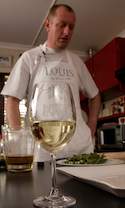It began at massive co-operative winery Vredendal (now Namaqua Wines) up the West Coast as a member of marketing genius Giel Swiegers' winemaking team. It was here that Louis soon made a name for himself with award-winning reds. 'But I don't like· to be pinned down or associated with any particular variety or style.' It's clearly the rebel speaking.

The young winemaker Louis Nel then moved on to emerging big-name, big-budget, but by comparison 'boutique', winery Vergelegen in Somerset West as assistant to Martin Meinert.
Meinert had been the incumbent overseeing vineyards and cellar here since the 1989 renaissance of one of the Cape’s most historic early seventeenth-century wine estates by new owners, mining house Anglo-American.
Louis found himself working with a small selection of newly planted, premium varieties on virgin viticultural terroir in the much-talked-about, French-designed, state-of-the art multi-level cellar sunk into a hilltop to introduce a gravity-fed winemaking system believed to be integral to top-quality wine.
He shared a cellar with Meinert, a former journalist with an existentialist bent, a qualified winemaker and an inveterate world wine traveller who had worked harvests in California, Chile and France (where he had close ties with Bordeaux icon Château Lafite-Rothshild). Louis has travelled to France on working stints several times.
When Meinert left towards the end of 1997 to concentrate on his own small wine farm, Louis took care of things until the arrival in early 1998 of big, brash Andre van Rensburg as Vergelegen's new cellar chief, whom he assisted through the harvest before himself leaving to join Neil Ellis Wines in Stellenbosch.
Ellis had pioneered the concept of a negociant winemaker in the Cape. He was a veteran vintner who'd carved a career out of sourcing grapes for vinification from carefully selected and nurtured sites all over the Winelands and eventually established a base at Oude Nektar in the Jonkershoek Valley.
In collaboration with a new farm owner there, he'd built a cellar and planted some prime previously unexplored cool-climate sites to main reds.
Louis was brought on board as an oenologist/winemaker, one of the 'specialists' handp_icked to help build Neil Ellis Wines.
Shortly after his arrival at the cellar he was sponsored on a three-month working trip to Oregon in the United States and spent the next three vintages working for a wine man known as a hard taskmaster, meticulous, with exacting standards.
'I have worked at many places,' says Louis, 'but one of my most memorable was Neil Ellis Wines.
I consider Neil to be my ultimate mentor: he taught me to always stick to the basics and not convolute things; he is an absolute sage.'
Louis had been in on the development of Vergelegen's fine sauvignon blanc - one of his favourite varieties - from the vaunted Schaapenberg hill overlooking False Bay.
At Neil Ellis he found himself again working, not only with great reds, but with sauvignons from the then-new Darling area, which Ellis had been instrumental in developing (among others) as a prime sauvignon site.
 Hearty and zesty lamb knuckle casserole recipe by Lois Nel served with couscous and paired with Louis Cabernet Sauvignon....
Hearty and zesty lamb knuckle casserole recipe by Lois Nel served with couscous and paired with Louis Cabernet Sauvignon.... This salad sauce recipe by Lois Nel brightens up any salad, paired with Louis Sauvignon Blanc wine....
This salad sauce recipe by Lois Nel brightens up any salad, paired with Louis Sauvignon Blanc wine....